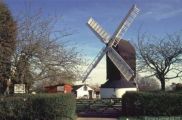
OUTWOOD IN SURREY "The Village with the Mill"
May 2013
What a difference a year makes. In 2012, based on the national mean temperature records, March was the hottest since 1957 whereas, March this year proved to be the coldest since 1963. The reason given is that the jet stream, which controls weather patterns in the northern hemisphere, shifted south in 2012 resulting in the year being the second wettest on record and unfortunately it remained down over the south of France: interestingly, the 1950's were affected by similar fluctuations in the jet stream. However, at the time of writing, midway through April, it has begun to move further north and temperatures have started to climb back to more normal levels coupled with a welcome increase in hours of sunshine. Sunday 14 April was the warmest day of the year so far in Outwood with the temperature reaching 20ᵒC, and the buds on trees and shrubs,which have been on hold for weeks, are beginning to break and in the late afternoon I saw my first comma butterfly of the year and one or two orange tailed bumble bees. Golden daffodils are at last in flower in gardens and alongside village lanes, camellias and magnolias are showing colour and blackthorn are covered in white blossom. Wood anemones (Anemonenemorosa) aka fairies' windflower in Dorset and granny's caps in Somerset and the bluebells, that quickly follow, are likely to be a good three weekslater than usual. However, despair not, nature will very quickly catch up and bythe time you read this, the countryside will be a riot of colour including the extraordinary palette of seemingly hundreds of shades of green so typical of spring.
In one respect birds are very like people who don't all go to the same supermarket for their food - they don't visit the same garden or feeders - and the result is that some species visit some gardens and other gardens not at all. This phenomenon regularly comes to light in the reports of bird sightings received from villagers. Green finches, yellow hammers and black
caps are only occasional visitors to our garden but are reported as regulars in others. There are likely to be a variety of reasons for this behaviour such as type of food and where and how it is presented such as in feeders or spread on flat surfaces, whether the garden isopen or more closed in with trees or buildings and the presence of cats and
other predators such as sparrow hawks. However, sometimes they are simply missed because they are mixed in with similar looking birds. One recent example was a report from John Hines, who kindly sent me copies of photographs he had
taken of reed buntings in his garden in Millers Lane. The reed bunting (Emberiza schoeniclus) also known as a bog, fen or reed sparrow is slightly larger and slimmer than a sparrow. The male has a distinctive blackhead and throat, a white neck collar, moustache and underbelly, with a black streaked, brown back, a long forked tail and a short strong beak typical of a seed eater. The female is duller with a brown streaked head. The species is found across northern Europe and is known to be the most adulterous of birds with nests often having chicks sired by different fathers.In the south of the country reed buntings remain resident all year roundand over recent years have extended their normal reed bed territory and spread into the countryside and during the winter visit gardens in their search for food.
Mike Johnson